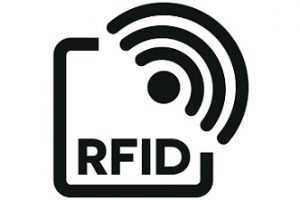RFID – Radio frequency identification

The principle of identification by radio signals dates back to the Second World War. It was then that aircraft were first equipped with radio beacons so that they could be identified as friend or foe. RFID, as it is applied today, dates back to the 1960s. Two Philips employees discovered how chips could be read remotely. The company ID Engineering then developed applications in the field of theft prevention. C&A was the first company in Europe to use the detection gates that are now widely known. The addition of a unique product code (EPC) and a management system led to the structure now known as RFID.
Radio frequency identification is a technology for remotely storing and reading information from so-called RFID “tags” that are placed on or in objects or living things. These tags can be ‘active’, ‘semi-active/semi-active’ or ‘passive’.
Active RFID tags are battery powered and can be read and written with a “remote transceiver” also called a “reader” that sends and receives radio waves with an antenna, active tags usually send their ID at an interval.
Semi-active tags only send their signal after being activated by the reader.
Passive RFID tags do not have their own energy source and send a response by converting the energy of the radio waves emitted by the reader.
There are also so-called chipless tags, which are used for simple identification tasks such as theft prevention. These are strictly speaking not RFID tags because they do not contain a unique identification number. They consist of a tuned resonant circuit that absorbs energy at a specific frequency.
RFID tags also differ by the frequency used. In general one can say: the higher the frequency, the further the reading range. However, higher frequencies have more difficulty with metal and moisture.
Frequencies
125 KHz – – – – – Low Frequency
13.56 MHz – – – – -High frequency
860 to 950 MHz – – -Ultra High Frequency
2,45 GHz – – – – -Microwave
Types of RFID tags
RFID tags come in a wide variety of shapes and sizes. They can be passive or active, read-only or read/write. Passive tags do not have their own energy source: they use the electromagnetic field of a reader to induce a current in the chip. Because of this, the signal does not travel over a large distance (from a few centimetres to about five metres). Active tags themselves have a battery to activate the chip and can transmit a signal over a greater distance (from about 100 metres to even a few kilometres). Anyone in possession of bluetooth, a pda, mobile phone or laptop transmits such a signal and can thus be located to a certain accuracy. The amount of data can also vary from a few bits to more than 1 megabit. All these possibilities are, of course, also reflected in the price: a simple passive tag costs no more than thirty eurocents. Complicated RFID tags that are linked, for example, to sensors that also measure temperature or humidity are considerably more expensive (sometimes as much as € 100,- each).


